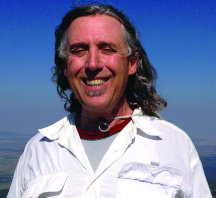No products in the cart.
Favorite Climbs

Part Two: Southern Ranges
Story and Photos by Tom Lopez
Last month, we published mountaineer Tom Lopez’s accounts of five summits in northern Idaho ranges, drawn from a list of his twenty-five favorite climbing experiences in the state. This month, in the concluding part of the series, he showcases a half-dozen peaks in the central and southern parts of Idaho.
Mount Regan, Sawtooth Range
After Dana Hanson and I scrambled up the east ridge of Mount Regan, we encountered a smooth vertical wall blocking our way. We were fewer than thirty feet below the summit, but were ill-equipped to climb the wall. We had not expected that the route would require technical climbing and had not brought a rope. We sat catching our breath and considered our predicament. I often believe discretion is the better part of valor, but no climber wants to turn around on a beautiful day thirty feet below a stunning pinnacle. Summit fever drives on many of us in the face of adversity. This day, I was in the grip of that fever.
The Sawtooth Range needs little introduction for most Idahoans, who rank it as one of Idaho’s most important resources, along with the Salmon River and potatoes. The best-known of the state’s many mountain ranges, it’s also the ancestral home of Idaho mountaineering, where famous climbers including Robert and Merriam Underhill, Fred Beckey, Louis Stur, and Lyman Dye set a high standard. The eastern escarpment of this rugged collection of granite peaks and alpine lakes is perhaps Idaho’s most impressive mountain backdrop. At least fifty peaks that exceed ten thousand feet in height are scattered throughout the range but many other spires and towers crowding the high ridges also present challenging climbs. The main Sawtooth Crest stretches more than thirty-two miles from north to south and twenty miles from east to west, but when I think of the Sawtooth Range, two peaks immediately come to mind. The first is Mount Regan. This stunning beauty likely has graced more calendars than any other Idaho peak, and its slopes have drawn climbers at least since 1934, when the Underhills and Dave Williams made the first ascent. When Dana and I made our assault in August 1986, we followed the Underhill route, which is a classic mix of broken rock talus, a sharp ridge, and a summit block so forbidding that the very sight of it makes you doubt your skills.
I looked upwards, searching for a way to ascend the wall, or more precisely, a way to get down if we made it up. At the far right side, a narrow ledge skirted the wall and possibly led to the peak’s north face. Gingerly, I stepped onto it and worked around to a larger ledge that did lead me to the middle of the peak’s north face. Dana followed. We were in a shady alcove. The rock above us was broken but still nearly vertical. To the north there was nothing but air. The drop was close to vertical, all the way down to Sawtooth Lake nearly two thousand feet below. We did not feel confident. In fact, we decided to quit. But my mind stewed: “It’s a long way to come,” I thought. “I can climb this wall. It’s nothing I haven’t done before. Ignore the drop.” I faced the wall, shouted, “Dang,” and started up. Moments later, I was on the summit. The thirty feet of rock had looked bad mostly because a fall could be fatal. Dana made it to the top, too. Rank: 8.
This content is available for purchase. Please select from available options.
Register & Purchase Purchase Only
Register & Purchase Purchase Only

